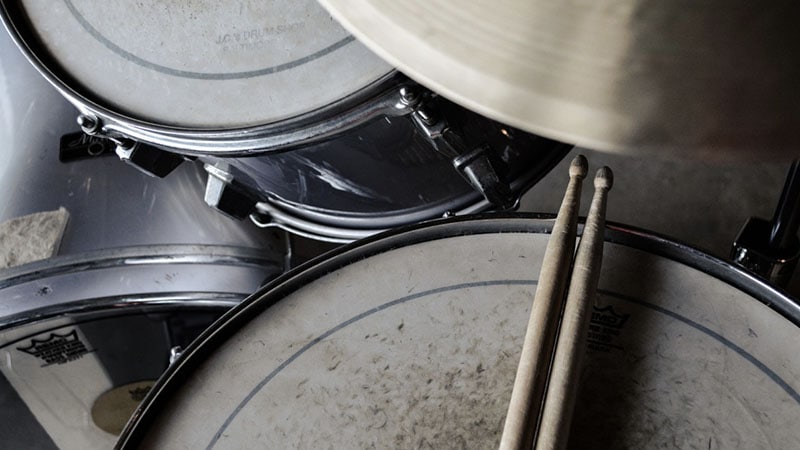© All rights reserved Copyright 2024
What are Drum Heads?
Easy Drum Beats
What are Drum Heads?
Drum heads are the thin material pieces that you’ll find attached to the top and bottom of drums. You’ll find a wide range of drum heads as they vary in size, thickness, type, and sometimes material.
They’re something that beginner drummers don’t worry too much about, but all drummers eventually discover their importance as they have the power to completely change the sound of a drum kit.
We’re going to break down everything there is to know about drumheads. After reading this, you’ll know exactly how to choose a good head and where to put it. Let’s go!
Resonant Heads or Batter Heads:
Whenever you buy a drumhead, you may see the words resonant or batter in their names. These are the two main types of heads. A batter head is the drum head that goes on top of a drum. It’s the one that is intended to be hit with sticks. Because of this, batter heads are generally a lot more durable.
Resonant heads are the ones that go on the other side of the drum. They’re not intended to be hit. Instead, they control how much a drum resonates from the bottom. They’re always a bit thinner than batter heads. A thick reso head will choke a drum out quite quickly.
It’s vital that you know the difference between these two as you don’t want to mistakenly put a batter head where the resonant head should go and vice versa. However, some batter heads are thin enough to be used as resonant heads, making them the exception.
Another thing to note is that snare drums have very specific resonant heads called snare side heads. If you put the same reso heads on a snare that you would for a tom, you’re not going to get a good snare sound. The reason for this is that snare side heads are even thinner than standard resonant heads. They’re thin to allow maximum responsiveness from the snare wires.
Table of Contents
ToggleHow to Choose a Drum Head?
There are multiple deciding factors when choosing a drum head. Drum heads are made in different ways and that causes them to have varying tones and textures. It’s very common for drummers to have a group of favorite drum heads as they’ve played a few and stuck with the ones they liked the most.
You choose a drum head by checking how many plies it has, seeing how it feels, deciding if it’s appropriate for the style of music you play, and choosing whether to get a clear or coated head.
If none of that makes sense to you, read on as we’re going to explain it all. However, it’s important to mention here that the process of finding the best drum heads may take a while. Buying many different ones can cost a large amount, so don’t be discouraged if you haven’t found some good ones yet. Use the ones that you have, tune them up as best you can, and save up to get a new set of heads.

Difference Between Single and Double-Ply Heads
Another defining factor of a drum head to take note of is whether it’s a single or double-ply head. A single-ply drum head only has a single sheet of Mylar across the surface. These heads bring a lot of overtones out of the drum, and they’re very sensitive.
A double-ply head has two layers of Mylar. It’s a lot thicker, causing the drum to be muffled more than it would be with a thin head. Double-ply heads are typically more durable and they’re not as responsive.
Single-ply heads sound the best when they’re used on high-quality drum sets. They bring out the purest tones from the shells as they don’t limit the sounds. They don’t sound as good on cheaper sets since the tones aren’t as great and the overtones are often unbearable.
Double-ply heads are the best answer for making cheap sets sound better. The extra muffling helps drastically. They work fantastically on more expensive sets as well. They’re also great for heavy-hitters thanks to their durability.
Double-ply heads are also a lot easier to tune than single-ply ones. Any drum that is muffled more is easier to tune, so the extra muffling on double-ply heads is the big contributor to the ease of tuning.
You may occasionally find a 3-ply head. These aren’t very common, though. They have much more muffling than double-ply heads and they’re even warmer in tone.
Coated heads or Clear heads
You’ll find that some heads have coated surfaces while others have clear ones. Many drum heads let you choose which option to get. For example, you can get a Coated Evans G2 or a Clear Evans G2. The easiest way to note the difference is by the transparent surface on the clear head and the white surface on the coated one.
Clear heads have a warmer sound. You could think of the tone they bring out from the drum as a bit rounder than what a coated head brings out.
Coated heads have more of a distinct attack. They bring out more articulation from the drums. Coated heads are also essential if you want to use brushes as brushes don’t make a strong sound when played on clear heads.
In simple terms, a clear head will make a tom go “boof” while a coated head will make it go “doof”.
Some heads will have different colors. You may find a black or blue head. Just remember that coated heads always have solid colors while clear heads are always transparent.

One of the cool things about drum heads is that different ones cater well to certain styles of music. While any drum head would fit and do a good job, some are more preferred than others. They’ll also make it easier to get the tuning needed for that style.
For example, single-ply coated heads are the best option for jazz drum kits. They’re ideal for brushes and they allow you to get high and resonant tuning quite easily from the drums. If you were to use clear double-ply heads, it would be a lot harder to get the distinct jazz sounds that the drums need.
Since double-ply heads are more durable, they’re a better option for rock and metal drummers who play with intensity. They’ll last a lot longer than single-ply heads would after frequent gig playing.
FAQ:
Do varying drum heads make a difference?
Yes. Varying drum heads make a significant difference to how a drum sounds. The biggest factors would be whether the drum head is clear or coated, single-ply or double-ply. Other than that, certain heads have unique design features that alter their sounds slightly.
If you’re looking to get a certain sound out of your drums, you’d need to find a drum head that makes it easily attainable. After that, it all comes down to tuning. How you tune your drums is more important than what heads are placed on them.
How do drum heads work?
Drum head companies design drum heads so that they fit perfectly on drums. All drums range from around 6” to 26”. So, you can find drum heads in those sizes.
A drum head will be placed on the bearing edges of a drum. Once there, you have to tighten it with a drum key. As you tighten it, the surface starts to stretch. When it’s stretched enough, you’ll be able to hit the surface to get a nice sound from the drum.
You can then tune tighten the lugs around the head to alter the sound of the drum. The tighter the lugs are, the tighter the head will be stretched, and the higher-pitched the drum will sound.
Do drum heads affect sound?
Drum heads are one of the main contributors to how a drum sounds. Your choice of drum head has the potential to change how your drum sounds when you play it.
The main factor that determines how your drums sound is how you tune them. However, your drum head choice will also affect how easy it is to tune the drums. So, choosing the best drum heads you can is very important.
What are the Best Drum Head Companies?
The top drum head companies are Aquarian, Remo, and Evans. These are the brands you’ll see the most when looking for heads. They also offer the safest products to go with as they’re so popular with drummers all around the globe.
Conclusion
Once you know exactly which qualities to look for, choosing drum heads becomes an easy process. If you didn’t know about different drum heads until now, we highly encourage you to get some high-quality ones for your drum set.
When you buy a kit, it comes with stock drum heads. Stock drum heads are quite bad 90% of the time, and getting higher-quality heads for the drums will make a world of difference.